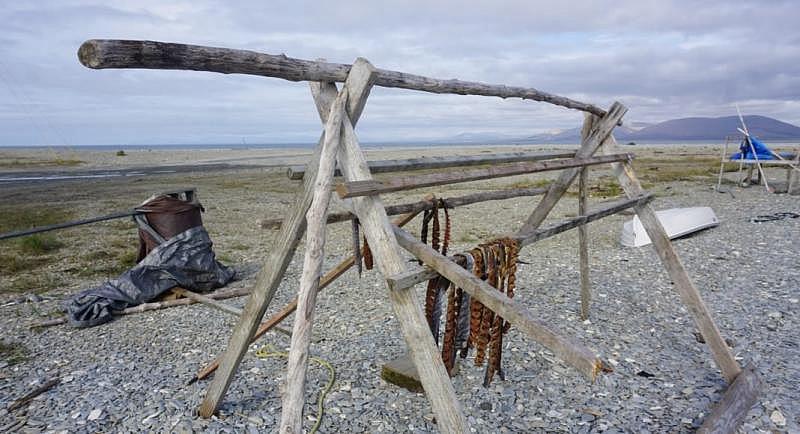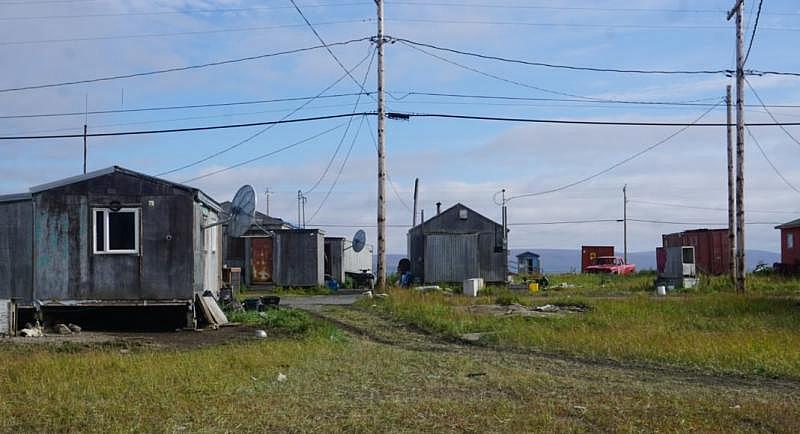Part 1: For some Alaska villages, the lack of modern water and sewer service means more health risks
This story is part of a series produced by Yereth Rosen, a participant in the USC Annenberg Center for Health Journalism’s 2021 National Fellowship.
Other stories in this series include:
Water and sanitation deficiencies worsened the COVID pandemic in rural Alaska, a study finds
How COVID is helping spur big investment in Alaska water and sanitation services
Part 2: In-home water and sanitation systems offer alternatives to serve remote Alaska villages
Part 3: How better design can make rural Alaska homes healthier
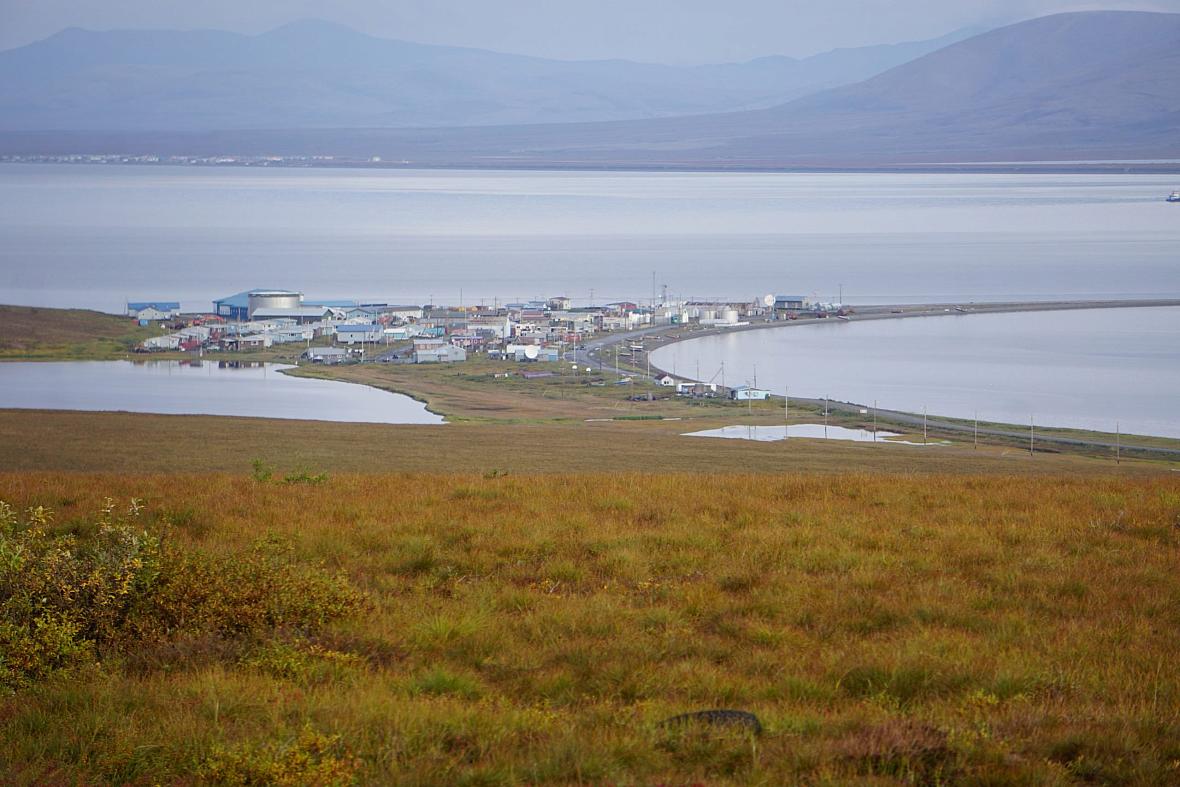
The village of Teller, Alaska, located on the Seward Peninsula, is one of 31 villages in the state where virtually every home lacks pipes to supply fresh water and dispose of sewage.
(Yereth Rosen)
The COVID-19 pandemic has highlighted health disparities long endured in many Alaska Native villages. Now, informed by the lessons of the pandemic, Alaskans are making investments and using research and design to build a healthier future in rural and remote areas. This is the first of a series that tells their stories.
On a ridge rising over the Bering Strait coast lies the resting place for one community’s sewage.
In Teller, an Iñupiat community of about 250, homes have no flush toilets — nor are there pipes carrying waste to municipal treatment plants. Instead, there is a dumpsite about 5 miles from town for plastic bags filled with urine and feces, many of them punctured and leaking.
This is what is known in Alaska as a “honey bucket lagoon” — a disposal site for the contents of the 5-gallon buckets that serve as toilets for Teller’s residents.
“At least it’s not overflowing,” said Blanche Okbaok-Garnie, Teller’s mayor, who shielded her nose at times when the wind carried the stench from deposited waste and the containers that held it.
That makes the current site is an improvement over a previous honey bucket lagoon, Obkaok-Garnie said. The old site, at a slightly lower elevation, was “too tiny and too full” and was, through repeated freeze-thaw cycles, threatening the drinking water source below, she said. But even this new site, started in 2017, is on borrowed time, she believes. “I think it needs to be designed for permafrost more. It just won’t last,” she said.
Managing sewage and protecting clean water for drinking and washing can be a daunting challenge for many communities — often predominately Indigenous — in rural Alaska and elsewhere in the Arctic, where the lack of facilities combines with challenging conditions made increasingly uncertain as the Arctic quickly warms.
Arctic residents without piped water or sewage service — or with service that is substandard — have long faced higher rates of contagious diseases. The COVID-19 pandemic is no different; Alaska Natives make up 16 percent of the state’s population but as of early September, accounted for 29 percent of the state’s COVID deaths.
So-called "honey buckets" are the norm for human waste disposal in Teller. The city provides a pick-up service for a monthly fee of $35. (Yereth Rosen) Human waste is collected in plastic bags in honey buckets, before being hauled to a sewage lagoon. (Yereth Rosen)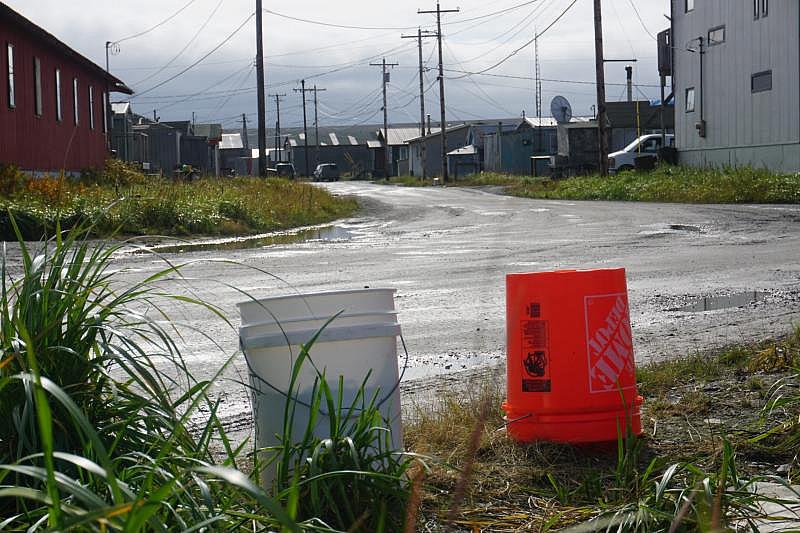
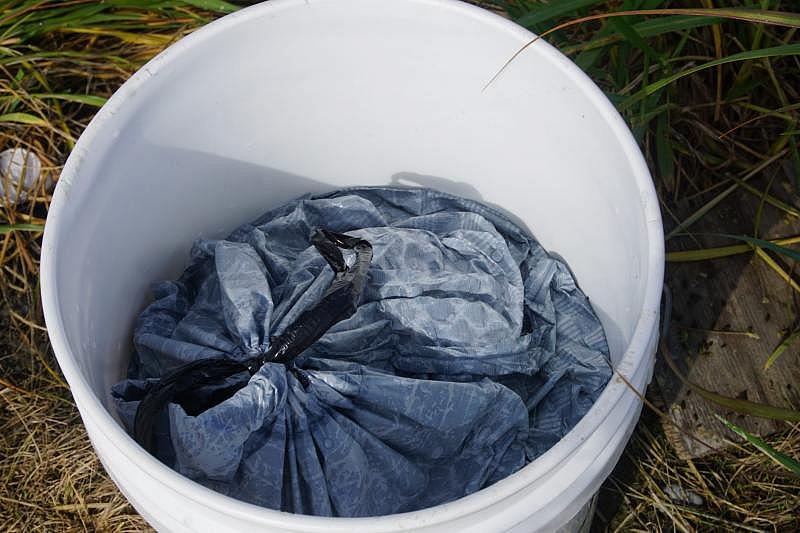
The pandemic helped spur a national response. The just-signed Infrastructure Investment and Jobs Act includes $3.5 billion in Indian Health Service sanitation facilities construction program, with work to be phased in over five years, plus $230 million for the Environmental Protection Agency’s grant program for village water and wastewater projects.
It was a compelling case among her colleagues, said Senator Lisa Murkowski, the Alaska Republican who helped craft the legislation. “When I tell them and I show them pictures about what happens in some of our communities where we’re dumping, children are hauling buckets of human waste and dumping it into a lagoon, they’re shocked,” she said at a Nov. 10 news conference.
The most critical needs in Alaska are in communities such as Teller, one of 31 villages in the state that are totally lacking in-home water and sewer connections and considered “unserved.”
But water and sanitation problems extend more broadly than those unpiped communities.
Several Alaska communities are classified as “underserved” because no more than half of the homes have piped-water service. Elsewhere, running water and sewer service might be available, but it is substandard and vulnerable to disruptions. And even in larger hub communities, some residents can’t afford the monthly utility fees or necessary home upgrades to escape the honey-bucket system.
Poor water and sanitation service means more disease
The connection between poor water and sanitation service and poor health is well-established in Alaska and elsewhere in the North. There is a long list of related illnesses and maladies in rural Alaska and the Arctic that have been chronic problems for decades. They range from respiratory diseases to skin infections to tooth decay. One of the most pressing problems has been infections of respiratory syncytial virus, or RSV, which plague babies and young children in rural Alaska and similarly situated areas of Arctic Canada.
In the far-flung villages of southwestern Alaska’s Yukon-Kuskokwim River Delta, the state’s poorest region, the RSV outbreaks and other respiratory problems are especially severe for babies and young children, a top Alaska health official told U.S. senators earlier in the year.
“We expect that one out of every three of our infants every year in one of those communities will be hospitalized simply because they don’t have running water,” Valerie Davidson, president of the Alaska Native Tribal Health Consortium, said in testimony at a U.S. Senate hearing in March.
Davidson, who is Yup’ik, had her own experience with RSV: Her daughter was hospitalized as a baby for nine days with RSV. Her daughter developed lingering problems. “She has asthma and was hospitalized eight additional times for pneumonia by the time she was 7 years old, which is unacceptable in our country,” Davidson told the committee.
Those respiratory infections can have tragic outcomes.
In 2016, Okbaok-Garnie lost her youngest child, a baby boy, to pneumonia. She and her son had both been sick when things took a turn for the worse. She loaded him onto her snow machine and headed for the hospital in Nome 70 miles away. “He stopped breathing that night on my back,” she said. He was named Hunter; he was just 5 and a half months old.
Teller Mayor Blanche Okbaok-Garnie in her home. Her son, Hunter, died from pneumonia before he reached 6 months. (Yereth Rosen)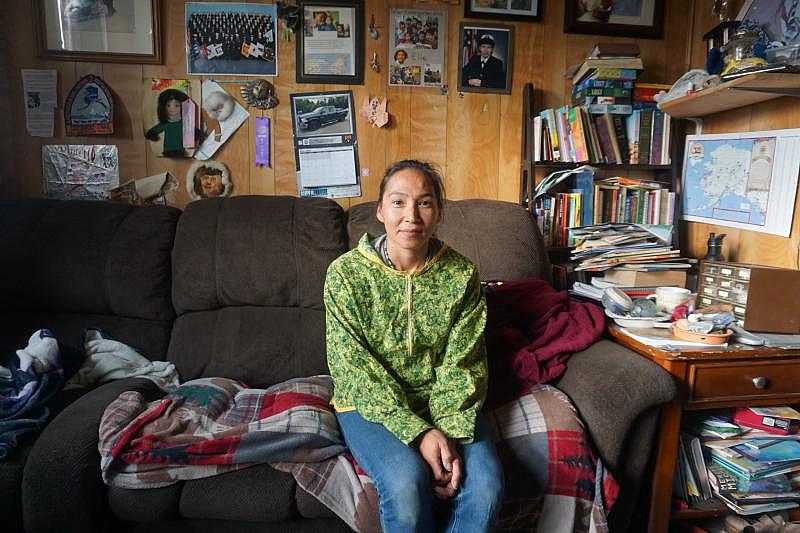
Okbaok-Garnie chose a small inland cemetery site for Hunter because the same permafrost thaw that is underlies the honey-bucket dumpsite is causing Teller’s main cemetery, located on a coastal bluff, to erode and sink.
“I put my son here because he died in winter and I wasn’t sure what all that erosion looked like under the snow, and I didn’t want to pick the wrong spot,” she said as she drove past Hunter’s gravesite.
Through the COVID-19 pandemic, the rural Alaska death toll has also mounted, especially in the early months before vaccines arrived. Much of the blame is put squarely on poor water and sanitation services.
Those rural Alaska services are better than they used to be. In the early 1980s, only about a quarter of rural Alaska homes had running water and indoor plumbing, but three decades later, that had increased to about 75 percent, according to the Alaska Department of Environmental Conservation.
Some communities are still waiting for service
Still left are the last unserved communities, encompassing about 3,300 homes. They are the most challenging cases.
Teller is typical of those communities.
There is a primary source for household water where residents fill up containers to haul home: a weather-beaten storage tank that rises above the city offices and “washeteria” in the village center that that offers limited piped-water services, including a laundromat and showers. The tank holds hold 1 million gallons and is filled with creek water sent by a community pipeline; it also feeds into the school, which has its own internal water system that extends to teacher housing but no further.
There is a standard way for getting rid of wastes, too. Urine and feces are deposited into trash bags within honey buckets. When filled, the bags are tied and the buckets and their contents placed outside homes for pickup on Monday, Wednesday and Friday by the city workers who truck the waste to the disposal site. Honey bucket pickup services cost $35 a month per household.
The routine of collecting water and getting rid of wastes, repeated throughout villages in rural Alaska and the wider Arctic, can be taxing. Clean water and dirty waste are hard to carry and easy to spill, especially when conditions are snowy, icy and slippery.
The difficulties translate to very limited daily water use, well below World Health Organization recommendations of 13.2 gallons per day, as many studies have documented. A survey of 21 households in one northwestern Alaska village revealed per-capita daily water use of 2.4 gallons, according to a 2016 ANTHC study; another study found that single-mother households in the region had even lower daily use. By comparison, the average daily per capita water use in the United States is 156 gallons per day, according to the ANTHC experts.
Zack Kitkon fills buckets with water from a supply provided by the city of Teller for 50 cents per gallon. Households in unserved and underserved communities in rural Alaska often make do with much less water than health experts recommend. (Yereth Rosen) John Kakaruk fills holding tank on a pickup truck for use in Teller's school. The city charges residents 63 cents per gallon for water from the larger hose. (Yereth Rosen)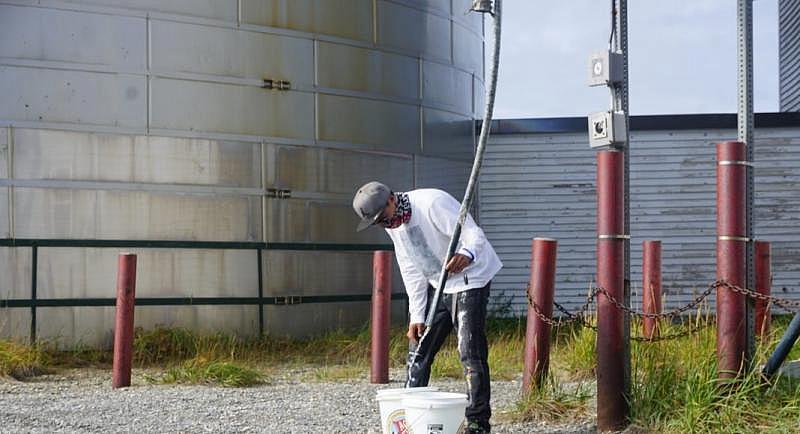
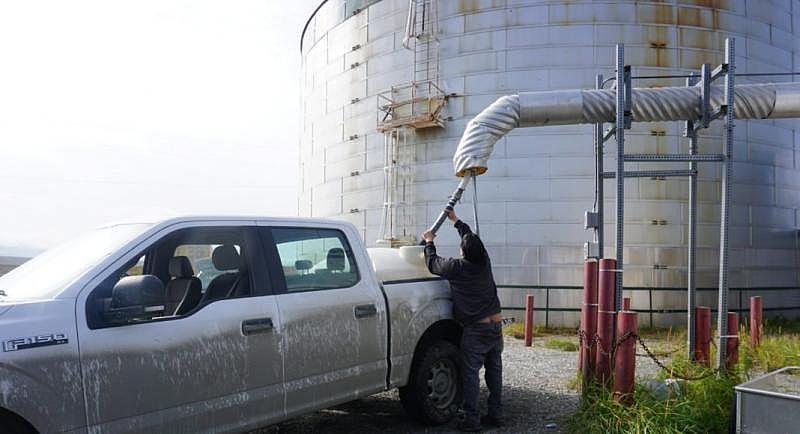
Medical advice about staying clean to avoid the spread of germs virus can be hard to follow in a place like Teller, where water is commonly reused to the point of contamination. “That’s what some people do is that they keep washing their hands in the same water, in a basin, until it looks dirty,” Okbaok-Garnie said.
For the remaining unserved and underserved Alaska villages, the cost is the main impediment to gaining running water and modern sewage treatment.
Economies of scale are practically nonexistent. Remoteness makes costs of water and sanitation service — like almost anything else brought in from the outside — staggeringly expensive. According to ANTHC, it would cost about $40 million to set up a comprehensive piped system in Teller, which is in line with costs for similar-sized communities that have gotten new systems. Ongoing operating and maintenance costs, which are generally covered by user fees, can be prohibitively high, especially for communities like Teller, where about a quarter of the residents are under the poverty line.
Climate change, which is thawing permafrost and speeding up coastal erosion, adds to the technical and economic challenges.
For example, the same permafrost thaw that is wreaking havoc on Teller’s cemetery and lurking below the honey bucket lagoon has caused slumps along the pipeline that carries fresh water from Coyote Creek to the community storage tank. In other communities, storm surges enabled by lack of sea ice have inundated freshwater reservoirs with saltwater. Breaches of sewage lagoons, caused by thaw, flooding or some combination, have been common in small villages.
Even systems in the larger and well-served communities are being hit by climate change.
In Utqiagvik, Alaska’s northernmost community and home to nearly 5,000 people, thaw is disrupting utility lines buried as deep as 12 feet in what was thought, at the time, to be solid and safe permafrost.
“Every year it seems to thaw a little bit deeper than it did before,” said Yves Brower, assistant superintendent of the Barrow Utilities and Electric Cooperative. Thaw damage to pipes usually can’t be detected until things go very badly, he said. “The only way we find out when it breaks is the water starts shooting up from the ground,” he said.
The expanded open-water season created by loss of sea ice poses other problems. Flooding could inundate the freshwater lagoon that is Utqiagvik’s drinking-water source, leaving the community without water for up to 60 days, warned a 2019 report from the U.S. Army Corps of Engineers. Flooding and coastal erosion threaten even the sophisticated 3.1-mile Barrow Utilidor, an enclosed, temperature-controlled, walk-through passageway encasing a portion of the city’s water, sewer, electrical and communications lines, according to the Corps’ report.
North Slope Borough crews work to protect the shoreline of Utqiagvik, Alaska from storm surges in an October 2018 file photo. As sea ice forms later and less predictably, coastal erosion can threaten sewer and water infrastructure even in communities that have it. (Yereth Rosen / Reuters)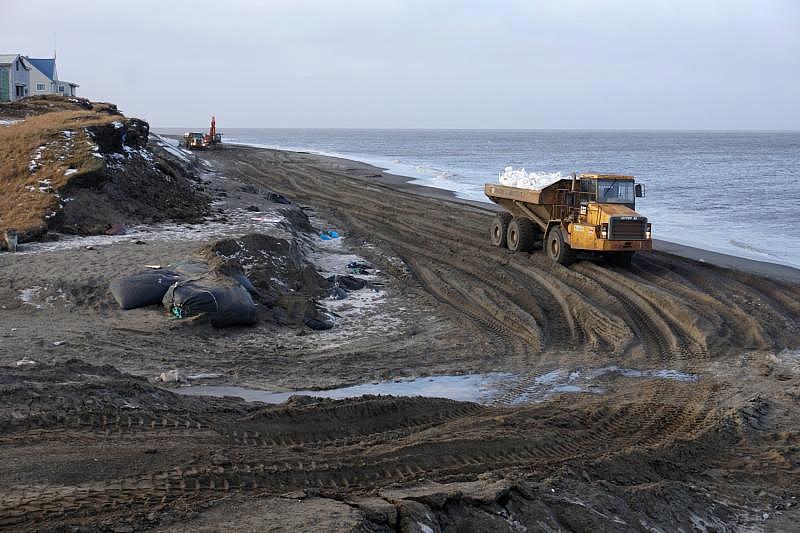
The Utilidor, built in 1984 with what was then a bounty of oil money, is much sturdier and better protected than the lines outside of it, but it is not impenetrable, Brower said. “If we had a big storm and it flooded the Utilidor, it would be catastrophic,” he said.
Climate change poses a particular cost-benefit dilemma for some parts of Alaska. Villages planning full or partial relocations to escape accelerated erosion can have a hard time making the case for water and sanitation investments in areas set to be abandoned in the future.
Shismaref and Kivalina, Inupiat villages in northwestern Alaska, are examples. Both villages are considered poster children for climate change, both are planning relocations, and in both residents remain on the honey bucket system.
The Infrastructure Investment and Jobs Act should provide enough money over the long term to address all the documented needs for Alaska rural water and sewer list, Murkowski has said. The benefits, however, will require a gradual rollout; the bill specifies a five-year period of payments, with the top national priorities yet to be determined.
Some quick action to contain COVID-19
While they wait for those long-term solutions, unserved and underserved villages have made some short-term and quick responses to the COVID-19 crisis.
Using money from the Coronavirus Aid Relief and Economic Security Act and other resources, regional Native organizations and the Alaska Native Tribal Health Consortium distributed bulk loads of masks and hand sanitizer, and even some new toilet seats for honey buckets.
The tribal health consortium also mobilized with partners, and with private funding that came through the Centers for Disease Control, to build and ship 100 handwashing stations over four months to unserved villages. Those include Teller, where Obaok-Garnie and one of her sisters have installed them at home. The units allow families to store 20 gallons of freshwater; with gravity, the freshwater flows into a sink used for washing.
A $20 million grant from a nonprofit foundation, the Helmsley Charitable Trust, is being used to address a nagging problem in the Bering Strait region — lack of the precise record-keeping and managerial capacity required to win federal and state grants.
The unserved Bering Strait villages, representing over 450 unpiped households, are now forming a co-op to put their financial systems in order. Teller, which has consistently struggled with record-keeping, hired someone to compile the past two years’ tax reports.


